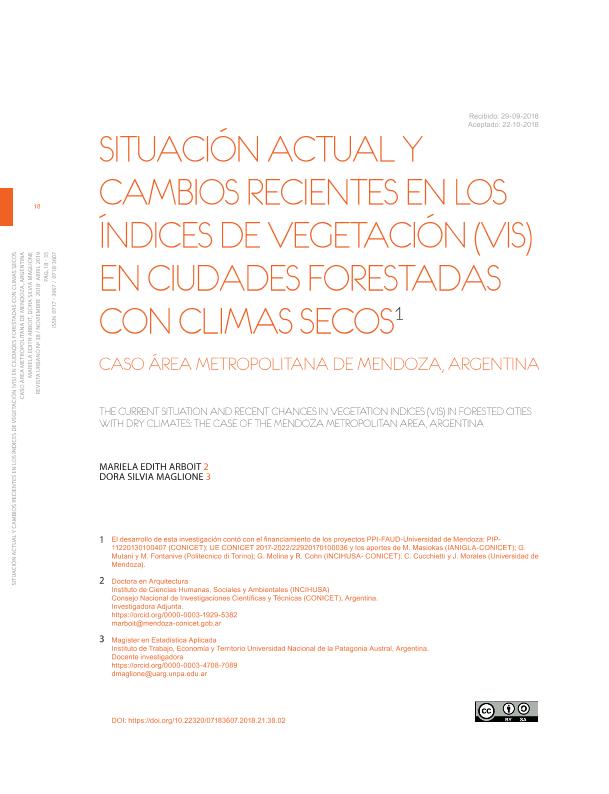Artículo
Las ciudades insertas en tierras secas se han adaptado a la escasez de recursos y a la complejidad antrópico-cultural del hábitat. La vegetación urbana es un elemento clave para la mitigación de los cambios climáticos y la resiliencia frente a la compleja problemática energético-ambiental relacionada con las morfologías urbano-edilicias. El objetivo del presente trabajo es estudiar las condiciones actuales y los cambios recientes en la vegetación urbana, analizando la variabilidad temporal y espacial del índice de vegetación de diferencia normalizada (NDVI) y el índice de vegetación ajustado al suelo (SAVI) en el área metropolitana de Mendoza (AMM).Metodológicamente, se determinaron los índices en sistemas de información geográfica (SIG) del análisis de imágenes satelitales Landsat 5 (1986-2011) y Landsat 8 (2013-2017) y se realizó un análisis estadístico de estimación de tendencias y correlaciones.Los resultados obtenidos indican una pendiente general descendente en los valores medios NDVI y SAVI en el período 1986-2011. Maipú y Guaymallén muestran las pendientes descendentes mayores, con prioridad de intervención en la toma de decisiones para resolver la tendencia, seguidos por Luján de Cuyo y Las Heras. Capital es el departamento con menor pendiente de descenso. En el período 2013-2017 se determinaron correlaciones positivas muy altas entre departamentos.Godoy Cruz es el departamento prioritario a intervenir en la estrategia de aumento en los índices de vegetación, considerando los resultados por departamento y por manzanas urbanas, para la totalidad de los años de estudio.Finalmente, los espacios verdes públicos del AMM prioritarios a intervenir se ubican en Las Heras para las estrategias de aumento en los valores de índices de vegetación y de aumento de superficie de espacios verdes públicos. Cities in drylands have adapted to the scarcity of resources and the anthropic-cultural complexity of the habitat. Urban vegetation is a key element for resilience and the mitigation of climate changes when faced with the complex energy-environmental issues related to urban-building morphologies. The objective of this research is to study the current conditions and recent changes in urban vegetation in the 6 municipalities of the Mendoza Metropolitan Area (MMA) by analyzing the temporal and spatial variability of the Normalized Difference Vegetation Index (NDVI) and the Soil-Adjusted Vegetation Index (SAVI). Methodologically, the indices were determined using geographic information systems (GIS) from the analysis of satellite images from Landsat 5 (1986-2011) and Landsat 8 (2013-2017), and a statistical analysis was carried out to estimate trends and correlations. The results obtained indicate a generally decreasing slope in the mean NDVI and SAVI values during the 1986-2011period. The municipalities of Maipú and Guaymallén show the greatest decreasing slopes, and should be given priority for intervention in decision-making to resolve this trend, followed by Luján de Cuyo and Las Heras. Capital is the municipality with the most gradual decreasing slope. During the 2013-2017 period, very high positive correlations were found between municipalities. The municipality of Godoy Cruz is the priority for intervention with the increasing vegetation indices strategy, considering the results by municipality and by urban block for the entirety of the years studied. Lastly, the public green spaces of the MMA that are the priority for intervention are located in Las Heras for the increasing vegetation indices and increasing the surface area of public green spaces strategies.
Situación actual y cambios recientes en los índices de vegetación (vis) en ciudades forestadas con climas secos: Caso área metropolitana de Mendoza, Argentina
Título:
The current situation and recent changes in vegetation indices (vis) in forested cities with dry climates: The case of the Mendoza metropolitan area, Argentina
Fecha de publicación:
11/2018
Editorial:
Universidad del Bío-Bío
Revista:
Revista Urbano
ISSN:
0717-3997
e-ISSN:
0717-3997
Idioma:
Español
Tipo de recurso:
Artículo publicado
Clasificación temática:
Resumen
Archivos asociados
Licencia
Identificadores
Colecciones
Articulos(INCIHUSA)
Articulos de INST. DE CS. HUMANAS, SOC. Y AMBIENTALES
Articulos de INST. DE CS. HUMANAS, SOC. Y AMBIENTALES
Citación
Arboit, Mariela Edith; Maglione, Dora Silvia; Situación actual y cambios recientes en los índices de vegetación (vis) en ciudades forestadas con climas secos: Caso área metropolitana de Mendoza, Argentina; Universidad del Bío-Bío; Revista Urbano; 21; 38; 11-2018; 18-35
Compartir
Altmétricas




